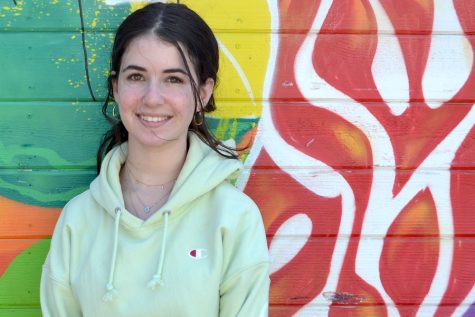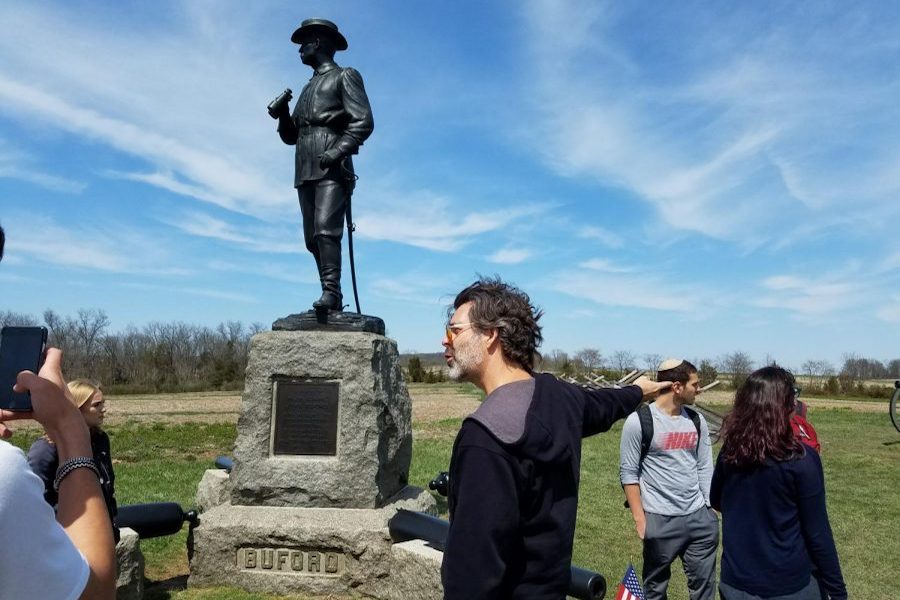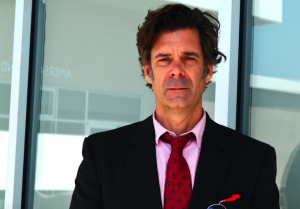Gettysburg 2018: On battlefield, comparing today’s sites to history
Student historians travel across the country, visiting battlefields and tourist shops to find the difference between what happened then and how it’s presented now.
BATTLEGROUND: In Pennsylvania, History teacher Dr. Keith Harris explained the scene at the monument to Union Major General John Buford, who chose the site for the battle of Gettysburg, recognizing its strategic importance.
A group of young historians made Shalhevet history last month when Dr. Harris’s SAS Civil War and Reconstruction class headed for Gettysburg, Penn., for Shalhevet first-ever out-of-state academic trip.
Over five days from April 21-26, these pioneers meditated in 19th-century warzones, walked in the footsteps of soldiers, took “ghost tours” and even taught Gettysburg local Jewish strangers about Haman, all while seeing their textbooks come alive. .
Junior Hannah Friedman said one of her favorite parts of it was marching a mile-and-a-half across the Gettysburg battlefield, following the path where soldiers had walked during the battle.
“It was just crazy, because you’re looking around and you’re realizing that this is exactly what they saw when they were here,” Hannah said.
On Monday, the group visited Devil’s Den, a rocky hill on the battlefield where they could see cannons, monuments and a view of Little Round Top, an important spot on the battlefield where 7,900 soldiers hs faced off on July 2, 1863. Eight hundred Union and 1,800 Confederate soldiers lost their lives that day. The students were asked to go off by themselves for half an hour and “meditate on the events that took place there,” according to Dr. Harris.
“We’re all by ourselves and you can just take in the sights and the sounds,” Dr. Harris said. “It was kind of quiet, and everybody just got to reflect on that.”
While many co-curriculars go on trips to compete, play sports, hear speakers or sing, this is the first time a class took a trip just to learn. The class trip was optional, and 14 out of 22 students in the class elected to go.
To learn more about the lives of the citizens of Gettysburg during the battle, the group visited the house of Jenni Wade, who was caught in the crossfire July 3, while making biscuits. She was hit in the back and became the only civilian to die at Gettysburg.
“We got to see what her life was like and how she helped the soldiers, and how it was detrimental to her in the end,” said Gabby. “Just to really experience that on a whole new level was just really life-changing.”
The students also explored area’s present-day commercial aspects, seeking to understand how the war was being represented through the hundreds of monuments spread throughout the park today.
Students said they talked about how the war is portrayed to the public more than about the specifics of the war.
Being a tourist hotspot, Gettysburg’s economy thrives off gift shops and touring companies, and Shalhevet visitors took a close look at how the area’s story was being told. Students were instructed to scavenge the gift shops and observe what was being sold there, as well as taking what’s known as a “ghost tour,” which takes visitors to places that claim to have paranormal activity or history.
“We went on a ghost tour ourselves, to see what are they trying to feed you, what kind of information,” said junior Adam Ritz. “It’s all about feeding the consumer, and its super interesting.”
What they learned, they said, was the monuments are more about the soldiers’ experience and less about the war itself.
They found that both sides of the war — the Confederacy and the Union — were presented equally at all attractions. In order to get a full understanding of the dynamic of the battle, it was necessary to analyze the monuments to see what truly happened.
“Looking at the battlefield, you would have no idea what happened,” said senior Shana Lunzer. “You wouldn’t know who the sides were, you wouldn’t know that it was a Union versus Confederacy thing, you wouldnt know that it was the Civil War… there were just tons of monuments everywhere.”
The group learned that almost all attractions in Gettysburg are catering towards tourists, and will tell them anything for a profit.

MONUMENT: SAS Civil War students survey the battlefield from the General John Reynolds monument on McPherson Ridge in Gettysburg National Military Park in Pennsylvania. Students called parts of the trip emotional and ‘life-changing.’ History teacher Dr. Keith Harris, pointing, explained the scene.
“What I learned in class was very different to what I saw on the battlefield,” said junior Mikey Khatan. “I learned that it was so gruesome and brutal, but everything we saw on the battlefield was so beautiful, and I couldn’t imagine it being that way.”
They also visited attractions such as the Gettysburg Cyclorama, McPherson’s Ridge, the Gettysburg Visitors Center, the Virginia State Monument. They also met with area historians and guides.
At the end of each day, the group came together and discussed and reflected on what they had learned that day. Topics ranged from “Memory and the Union War – What Monuments Say and What They Don’t Say” to “To Disengage or Not to Disengage?”
“We were on the battlefield from nine to five everyday, which was really intense and a lot of walking, but at the same time, we got to go home and we got to unpack it all and discuss it,” said junior Gabby Grunfeld.
“You learn something in the textbook, you see pictures, but when you actually get on the battlefield and you actually look through the town, it’s such a different and meaningful experience because it feels really real.”
Another monument the students visited was the Pennsylvania State Memorial, the biggest one on the battlefield. The group was able to walk to the top of the monument, gaining access to a view of the whole park.
“Just to be there with everyone and just reflect and look back on the entire battle was really crazy and really really meaningful,” said Gabby.
And although the trip was planned to be very educational and informative, it also had fun moments.
According to Adam Ritz, one was at an observation tower, where they encountered another group of students. Among them was a boy wearing a shirt that said “Haman” with a slash through it. The Shalhevet students decided to talk to him and asked if he was Jewish.
The boy said he was, and was one of only two Jews in his school district, and he also was not entirely sure what the shirt meant. The Shalhevet students proceeded to try to explain to him what it meant.
“I thought it was pretty funny that we found one of two Jewish kids in all of Gettysburg,” said Adam.
Dr. Harris said the schedule was busy but was planned in a way that changes could be made if desired.
“I would go to the kids, and I would say ‘We could do this, or we could do this. What do you think?” he said. “If the class dynamic is really taking a lot out of monument dedication speeches, then we will pour gas on that fire, or if the class is really interested in military minutiae, I could do that as well.”
He said the students’ favorites included the monuments, big troop movements and stories about individual soldiers.
Dr. Harris first had the idea for the trip in 2001, when he went on a similar trip as a UCLA undergraduate.
“I decided that visiting a sight of historical significance really enhanced the learning experience and made things that I read and learned in books and in the classroom really come alive in new and engaging ways,” said Dr. Harris in an interview with the Boiling Point.
He said proposed it to the administration last year when he began teaching at Shalhevet, and it came together this year after about nine months of planning. Before they went, the class spent about two weeks prior to the trip learning about the battle at Gettysburg.
Dr. Harris plans on continuing the trip for his future classes. All attendees contacted by the Boiling Point said that they would recommend the trip to future students.
“I think everyone should want to try and go on it, just because of how much fun it was,” said Adam Ritz. “We would be out in the battlefield, we would have eight- to nine-hour days… Then at night we would have time to chill, have fun and relax.”
After an educational and immersive five days at the battlefield, the group arrived back in Los Angeles as the first participants of what may become a new option for future Shalhevet students.

Kate Orlanski joined the Boiling Point as a staff writer during her freshman year and now serves as Features editor during her junior year. Outside of journalism, she is co-chair of the Young Americans for Freedom club, a member of the Model Congress team and secretary of the Agenda Committee.









